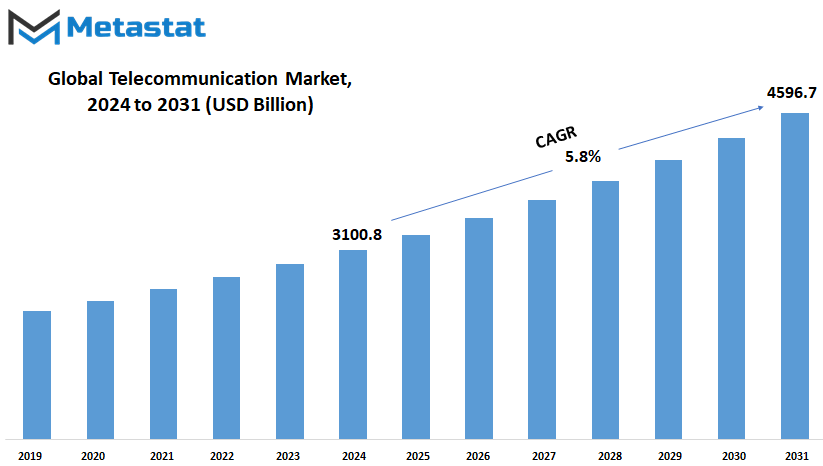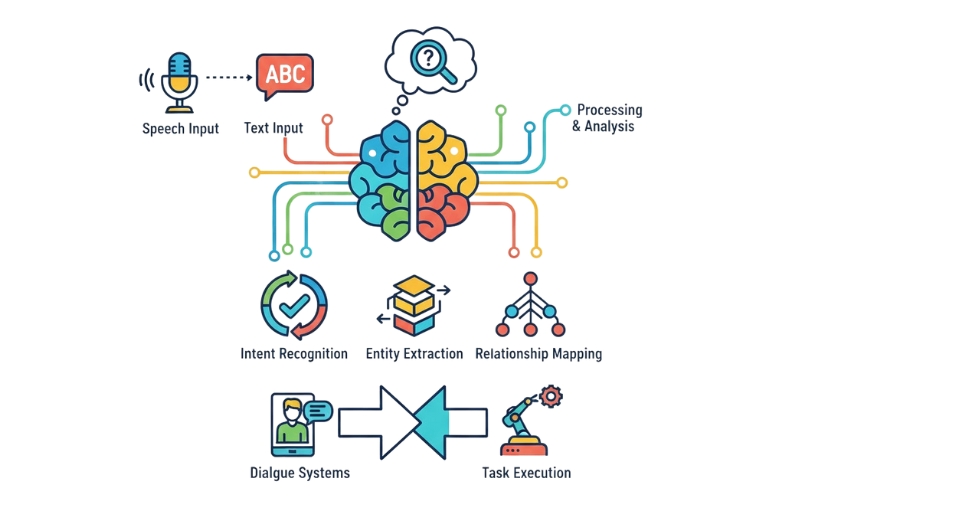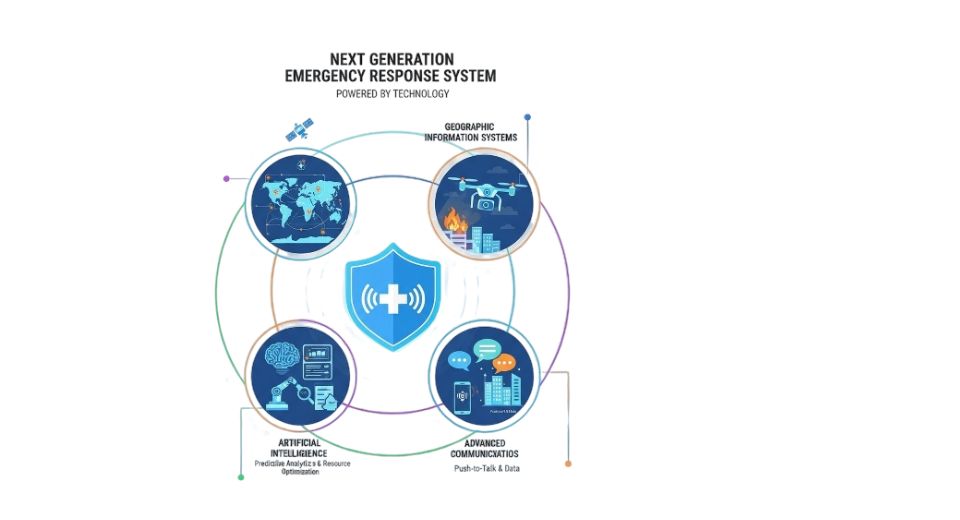MARKET OVERVIEW
The global telecommunication market is dynamic and vast. In fact, it is the backbone of connectivity in today's digital world, starting from a variety of services, infrastructures, and innovations to communication facilitation between people globally. The sector keeps redeveloping along with new needs and technologies, as it moved from voice communication, data transmission, mobile connectivity, internet service, among other areas.
The global telecommunication market has dramatically altered in the last couple of decades, powered by an immense technological evolution involving the changeover to digital networks from analog, a quick growth in mobile communication, and a rapid explosion in Internet usage. This caused a whole transformation in the way business enterprises function, people communicate, and governments operate. The whole paradigm of conventional boundaries has completely changed, connecting people worldwide.
In this regard, the basic idea of the telecommunications industry is to provide the fundamental infrastructure for voice, data, and video communication. Starting with space networks and submarine cables, everything plays a very important role in keeping communications continuous over long distances on Earth to terrestrial networks, colocation centers, and data centers. It can thus be concluded that, with technology still evolving, the future of the industry indeed relies on state-of-the-art innovations that can be 5G networks, fiber-optic technology, and satellite-based Internet services in order to completely revolutionize the way data is transmitted and received. Soon, the Global Telecommunication market will reach that future whereby, besides expanding the network capacity and its speed, attention will be paid to the growing demand for secure and reliable connections.
That is, as cyber threats are becoming more sophisticated, the need for advanced cybersecurity will also grow increasingly, along with the need for robust protocols of data protection. There will be a need to strike a proper balance between twin demands of expanding access and safety and privacy of users' data. Another development point within the Global Telecommunication market is to support the proliferation of IoT. With increasing IoHT proliferation, demand for high-speed and low-latency networks would turn out to be highly crucial.
This shall be in the direction of next-generation network development and deployment capable of handling huge data in real time, thus supporting smart cities down to autonomous vehicles, remote health monitoring, and smart homes. The level of sustainability and ecological responsibility will increase. In addition, the more global the concern about climate change, the more there is put on the telecommunications industry to reduce its carbon footprint, going greener. This could include investments in energy-efficient technologies, reduction of waste, and seeking methods of reducing any possible negative impact of network infrastructure on ecology.
After all, it is an industry that's always changing and therefore has always been at that strategic position that will always shape the future of communication, connectivity, and data transfer. It will be developed by changes in technology and regulations and also in consumers' needs. Going forward, the changing dynamics of these forces shift the market towards building the required infrastructure that enables sharing information on a global scale. The industry is right at the heart of facilitating global interconnectivity, and it will remain at the very forefront of driving innovation and progress during this digital era by pushing communications and connectivity to unparalleled levels.
Global Telecommunication market is estimated to reach $4596.7 Billion by 2031; growing at a CAGR of 5.8% from 2024 to 2031.

GROWTH FACTORS
Several causes are poised to ensure significant growth in the global telecommunication market. First, high demand for high-speed internet and other viable means of communication arises from the world over. In fact, the demand for good telecommunication infrastructure keeps ballooning since more people connect to the internet for streaming activities, working from home, online education, or digital transactions.
The development and deployment of 5G technology have become another crucial reason for this phenomenon. Compared with the previous generation, it promises a totally new landscape with faster speeds and lower latency, capability for wide ranges of devices to connect, offering new services and applications that cannot even be imagined with previous generations of mobile technology. The rapid adoption of smartphones and smart devices has contributed a whole new dimension to the growth of the global telecommunication market.
As these devices increasingly become integral parts of consumer and business communications, demands keep on increasing for better network coverage, data plans, and value-added services. Another huge contribution has come from IoT development. It connects the device and the system to one another for communication with each other for further execution of any automation task. It opens up new ways of creating value-added solutions and services by the telecom providers. However, factors might create a problem that could hinder the growth of the global telecommunication market. One of the challenges includes high costs with the deployment and maintenance of advanced infrastructure in telecommunication.
In most instances, building and upgrading networks requires huge investments, especially in less-developed or remote areas, which already presents a great barrier for many companies. Other concerns might impede the growth of the market, such as issues of regulation and cybersecurity threats. While telecommunication networks process an ever-larger volume of sensitive data, ensuring privacy and security becomes more intricate and a serious task. Any breach or failure here would result in the loss of trust by the consumer and hence slow down the growth in the market. However, over the coming couple of years, a few of the factors promise to work upwards for the global telecommunication market. New avenues are opening up as the digitization transformation is continuous in different sectors such as healthcare, finance, and education. In the future, more and more industries will be shifting to digital platforms, thus increasing demands for telecommunication markets, while focusing on reliable and secure communication networks.
Besides, the growth in the concepts of smart cities, coupled with the increasing clamor for sustainable development, may open further opportunities for the telecommunications market, as advanced networks become necessary for supporting the infrastructures and technologies for those ventures. With that in consideration, the future of the global telecommunication market indeed looks bright, with huge possibilities for further growth and expansion.
MARKET SEGMENTATION
By Type
Rapid strides in technology, combined with a high demand for connectivity, have promised to place the global telecommunication market at the threshold of a complete makeover. Growth perspective seems to indicate that with the expansion of digital communication, the market would witness tremendous growth in the coming years; thus, opening up new opportunities for innovations and investments. The diversified nature of the industry encompasses a number of segments that include telecommunication services, communication hardware, and satellite and telecom resellers. Each somehow contributes to the future of international communications: staying connected with efficiency and dynamism. Companies that develop and provide telecommunication services are the lifeblood needed for this industry to be considered such.
These range in type from the more conservative voice services to the more modern data services. These are expected to further increase, adapting to newer technologies like 5G and beyond. With 5G expected to be much faster, at low latency and with higher capacity, communications, work, and access to information will likely change. In the future, it might relate more to data-driven models for seamless connectivity between a variety of devices and platforms, culminating in a much more connected and responsive world.
Another critical segment involves communications hardware, which is all the needed physical equipment and structure that makes telecommunication networks possible. This includes everything, from mobile devices and routers to large-scale network infrastructure like fiber optics and cell towers.
With the expansion of the global telecommunication market, the demand for high-value hardware will surge even further to match the increasing data transfer rate to exponential highs and deal with massive digital traffic. This trend is thus expected to proceed further, where consumer pressure for better performance with longer battery life, driven by consumer demand, will continue. Future developments may involve the integration of artificial intelligence into devices to enhance their capability of managing data and optimizing network usage.
Satellite and telecom resellers represent the other important constituent part of the global telecommunication market. Satellites are increasingly being thrown into the basket as viable tools for reaching even the most remote and underserved regions of the world with access to the internet. This market segment is bound to see further growth in the coming years, as increased number of entrants start offering related services with low-cost, high-speed satellite internet.
Meanwhile, all this is going on; telecom resellers are still there to play their vital role in the distribution of these services and products at competitive prices to further drive customer choice. Thus, the future of the global telecommunication market is bright, with further development in technology that avails it with new avenues for growth and innovation in all of its segments. As the world shrinks closer, this would mean the market strives to keep up and find new ways to meet both consumer and business needs across the globe.

By Connectivity
The global telecommunication market is full of tremendous changes due to growth in the use of new technologies. Connectivity is the basis of this market in contemporary society. Therefore, it falls into two broad categories: wired or wireless. Each one of these contributes uniquely to shaping how people communicate, share information, and conduct businesses around the world.
Wired connectivity is achieved well within the bounds of viability for businesses and homes through the use of physical cables, namely fiber optics and copper wires. This often comes paired with high-speed internet that offers a stable connection-one that is in very high demand for services that are oriented towards large volumes of data: streaming services, online gaming, and video conferencing included. For this reason, wired connections are still applicable due to their capability to perform mass data transfer and establish secure and stable communication networks. Still, it would appear that wireless connectivity is to be regarded as the future of the global telecommunication market.
Ever since its convenience has been made possible by wireless technologies, both mobile networks, Wi-Fi, and satellite communications make it easier for people across the world to keep in touch with any other person anywhere in the world. Development and deployment of 5G take wireless connectivity to the next level by enabling faster speeds, lower latency, and higher capacity. It could be anything from further development of smart cities to expansion in the area of the Internet of Things, whereby even regular objects would connect to the Internet and provide an avenue for automation and data exchange.
But most important of all, technological advancements in wireless connectivity mean that seamless wireless connectivity will, sooner rather than later, become an absolute reality of the global telecom market. New technologies, such as 6G and above, have already reached the research and development stage, promising even higher speeds and more reliable connections that could support innovative applications, including augmented and virtual reality, remote health, and autonomous vehicles.
The progress made here will be contributing not only to increasing user benefit but also to unleashing new business models and revenue streams. Although wired connectivity remains in its place in the case of secure and stable communication, the future of the Global Telecommunication Market is to shift towards wireless connectivity. With advancements in technology, the world will witness new dimensions for connectivity that will change the way people live, work, and communicate with each other. It is bound to drive the global telecommunication market forward and make it one of the biggest sectors in the global economy for the coming future.
By Application
The global market for telecommunication has been growing at a very fast rate due to new technological developments in the market for communications and people's increased need to remain connected. This growing market can be realized within the various segments of the market, which are commercial and residential.
Demand for more reliable telecommunication services is on the increase in as far as the commercial sector is concerned. Business is always business, meaning that both small and large businesses need smooth communication links to function effectively. Office communications systems range from small packages to massive enterprise solutions that fit large-scale operations in the commercial market. With such high-end telecommunication technologies, business enterprises have no stopping in further boosting their productivity and broadening their venture into new venues.
That is expected to further escalate as businesses open themselves up to higher-end technologies like 5G-ensuring more lightning-fast data speeds and more reliable connections. Any integration of these technologies is bound to introduce more innovations attached to more business solutions and improved strategies of communication. On the other hand, the telecommunication market is also observing acute growth in the residential sector.
An increase in telecommuting and Internet use at home has risen the demand for increasingly high-speed Internet and reliable services of communication. This, in turn, has increased demand for home networking, fiber-optic connections, and advanced wireless systems. High-quality service at home is going to emphasize further development of the technologies toward the delivery of telecommunications services in residential locations. The companies in response are providing better and cheap internet packages with improved customer support services.
Accordingly, in the near future, the world telecommunication market will change further, facilitated by emerging technologies and changing needs of the subscribers. Commercial and residential sectors are expected to grow, though with unique challenges and opportunities. Immediate needs for business subscribers are integrations of new technologies as a competitive strategy, while those for residential subscribers are in access and quality of service improvements. Basically, the outlook for the future in the world's telecommunication sector is bright.
The unending improvement in technology promises an increased provision of sophisticated solutions that will benefit businesses and households equally. In this instance, the stakeholders would have to be adaptive and responsive to changes in the market to exploit emerging opportunities, bed in associated risks, and address user needs in new and innovative ways.
|
Report Coverage |
Details |
|
Forecast Period |
2024-2031 |
|
Market Size in 2024 |
$3100.8 Billion |
|
Market Size by 2031 |
$4596.7 Billion |
|
Growth Rate from 2024 to 2031 |
5.8% |
|
Base Year |
2022 |
|
Regions Covered |
North America, Europe, Asia-Pacific Green, South America, Middle East & Africa |
REGIONAL ANALYSIS
Global diversified regional segments, each with peculiarities and growth potentials, mark the global telecommunication market. The market broadly includes North America, Europe, Asia-Pacific, South America, and the Middle East & Africa.
The powerhouse economies of the United States, Canada, and Mexico drive the North American market. The United States remains at the front of one of the large technology innovation hubs, with continuous infrastructure advancement matched by some of the highest rates of new technology adoption. Canada has a high-speed network emphasis, and Mexico's recent growth in investment in telecommunications supplements the overall regional expansion.
Indeed, from the UK and Germany to France and Italy, among others, it truly ranges in high variation of markets: the UK and Germany stand for innovative technology and an excellent regulatory framework enabling competition with great attractiveness for investments, while France and Italy boast of evolving telecom policies with ever-growing investments in 5G and are among the most interesting actors in the shaping of the European telecommunication landscape.
These include countries like India, China, Japan, South Korea, and other parts of the Asia-Pacific region recording rapid growth through technological advancement. China, with its heavy population, had immense investments in 5G and smart technologies. India has the growing prevalence of expanding telecommunication infrastructure and therefore an ever-increasing number of its consumers also figures as a key player.
Japan and South Korea are known for having the most advanced technologies along with high-speed networks that raise the status of the region in the global telecommunication market. South America consists of the countries of Brazil, Argentina, and rest of the South American countries. Brazil is very significant due to its huge market and ongoing development in the field of telecommunication infrastructure. The efforts being put by Argentina to renovate its telecom sector and others in the region are in charge of growth and technological development.
Regional breakdown includes GCC countries, Egypt, South Africa, and the rest of the region. In front are GCC countries with key investments in telecommunication infrastructures and projects for smart cities, Egypt tries to connect everything together, while South African has shown the growth of demand for the services of telecommunications.
While these technologies continue to evolve even further, each of these regions will contribute uniquely to the presence felt by the global telecommunication market, carving a different trajectory of its future with its set of opportunities and challenges.
COMPETITIVE PLAYERS
Key players are making the outlook highly transformational for the global telecommunication market. The companies on the frontline bring different core competencies in the industry, including AT&T Inc., Verizon Communications Inc., and China Mobile Ltd. These big entities always compete with each other but shape the future in telecommunications through continuous technological advances together with strategic courses of action.
Actually, U.S. telecommunication giants like AT&T Inc. and Verizon Communications Inc. have been aggressively focusing on the expansion of their 5G networks. In fact, these companies race for superior connectivity to handle increasing demand for high-speed internet both in the urban and rural sectors. Of course, such advances in the field of internet speed and connectivity are sure to bring quite serious effects in spheres of business, education, and entertainment.
Similarly, Asia's largest player, China Mobile Ltd., long invested heavily in next-generation technology with a view toward developing 5G infrastructure. Finding new uses for telecommunication technologies is important to keep the competitive advantage ongoing. Because the scale of this market is so large, what China Mobile does will have a far-reaching implication in global telecommunications.
Meanwhile, no less notable initiatives have been pursued by companies like Vodafone Group Plc and Nippon Telegraph and Telephone Corporation, widely known as NTT. Vodafone, possessing a widespread international presence, tries to use its international network in the most effective way for the development of new services and solutions. In its turn, NTT makes attempts to connect high technologies with the provided services for the sake of making communication more effective and practical.
The other great contributors to the industry's growth are Deutsche Telekom AG, SoftBank Group Corp., America Movil-further development of their services, putting into use emerging technologies. Thus, deutsche-Telekom is leading in Europe, while SoftBank Group Corp. is in Japan and goes on in its development and elsewhere. America Movil is significant in Latin America and does its best to invest as many efforts as possible into the network and service expansion in the region.
Other major players that would equally not want to be left behind in the telecommunications industry include Orange S.A., Telefonica S.A., and British Telecommunications plc. Each of these companies is trying to have a tight grip on Europe and Africa, Latin America and Spain, and UK network infrastructure, respectively.
Major players in the future will further invest in development in technology and infrastructure, which most assuredly is certain to go a long way into driving the global telecommunication market. The contribution is toward the connectivity and communication among the people, henceforth raising the bar for the companies involved in the industry, thereby promoting more innovations on a global scale. Accordingly, such companies will continue to play the lead role in the development of the market and participate in the course-setting of prevailing trends towards moulding the future insofar as global communications are concerned.
Telecommunication Market Key Segments:
By Type
- Telecommunication Services
- Communications Hardware
- Satellite & Telecom Resellers
By Connectivity
- Wired
- Wireless
By Application
- Commercial
- Residential
Key Global Telecommunication Industry Players
- AT&T Inc.
- Verizon Communications Inc.
- China Mobile Ltd.
- Vodafone Group Plc
- Nippon Telegraph and Telephone Corporation (NTT)
- Deutsche Telekom AG
- SoftBank Group Corp.
- America Movil, S.A.B. de C.V.
- Orange S.A.
- Telefonica S.A.
- British Telecommunications plc
- Bharti Airtel Limited
- China Telecom Corporation Limited
- Comcast Corporation
- SK Telecom Co., Ltd.
WHAT REPORT PROVIDES
- Full in-depth analysis of the parent Industry
- Important changes in market and its dynamics
- Segmentation details of the market
- Former, on-going, and projected market analysis in terms of volume and value
- Assessment of niche industry developments
- Market share analysis
- Key strategies of major players
- Emerging segments and regional growth potential








 US: +1 3023308252
US: +1 3023308252






